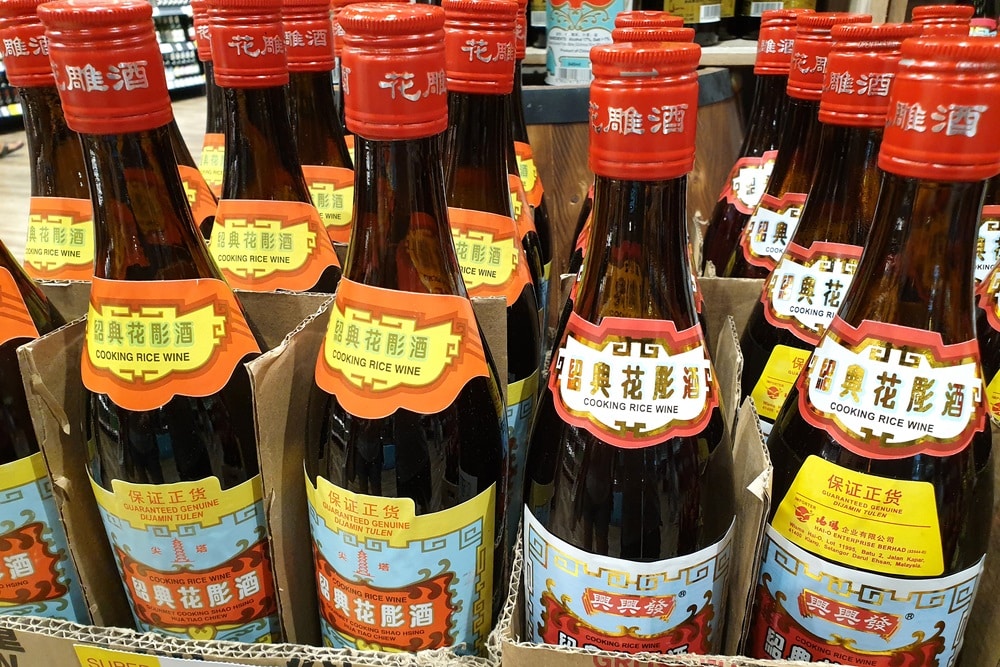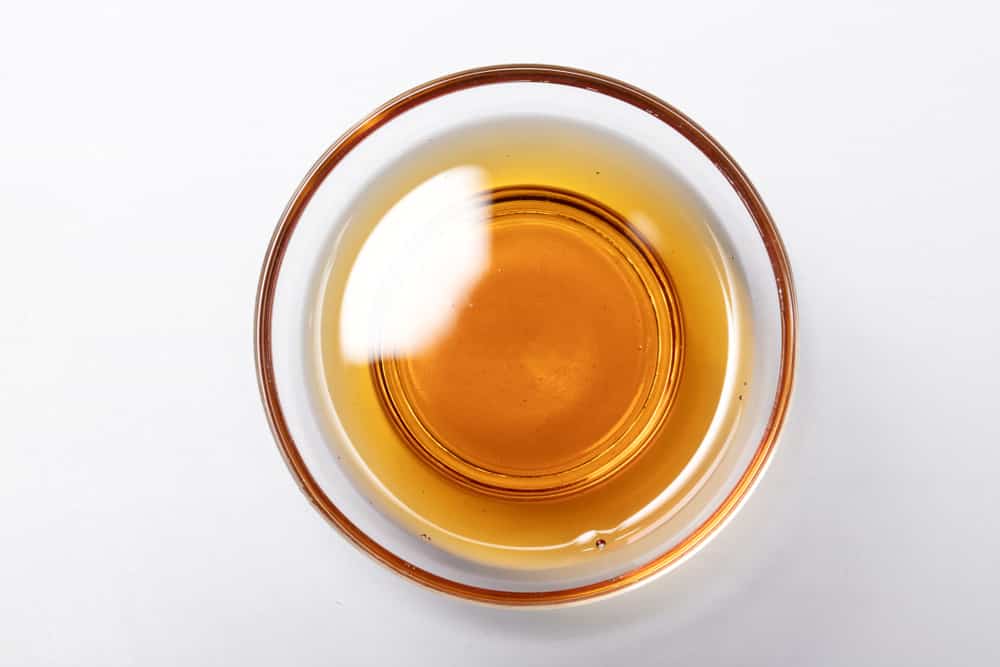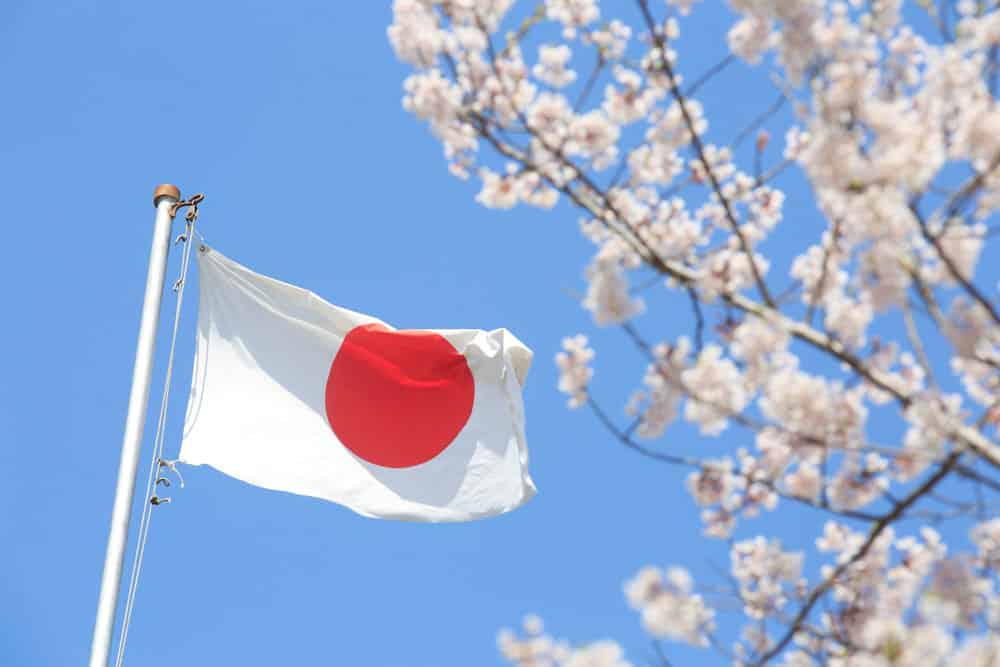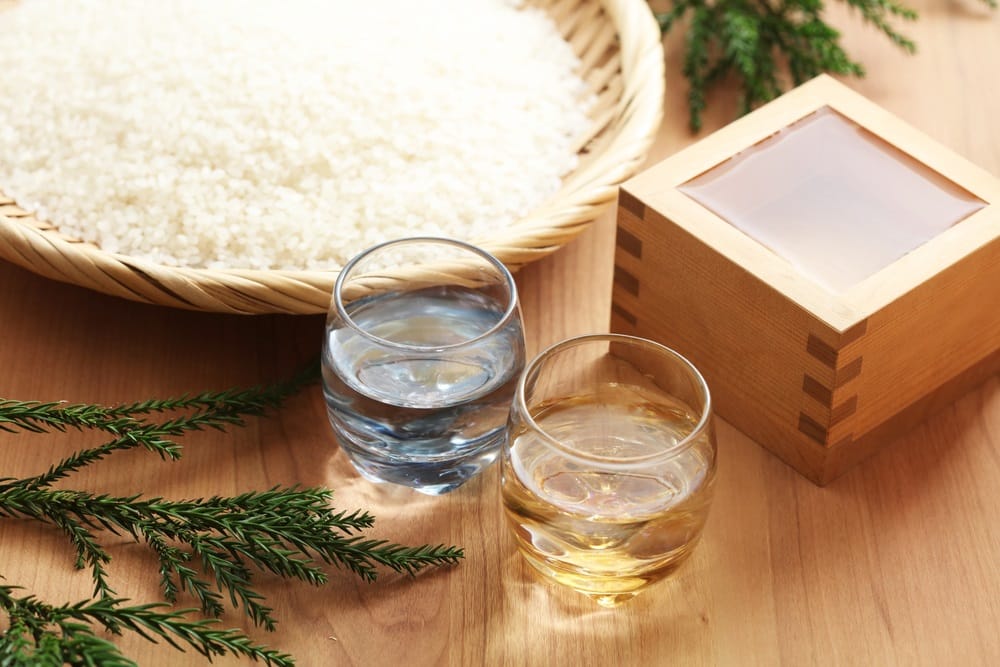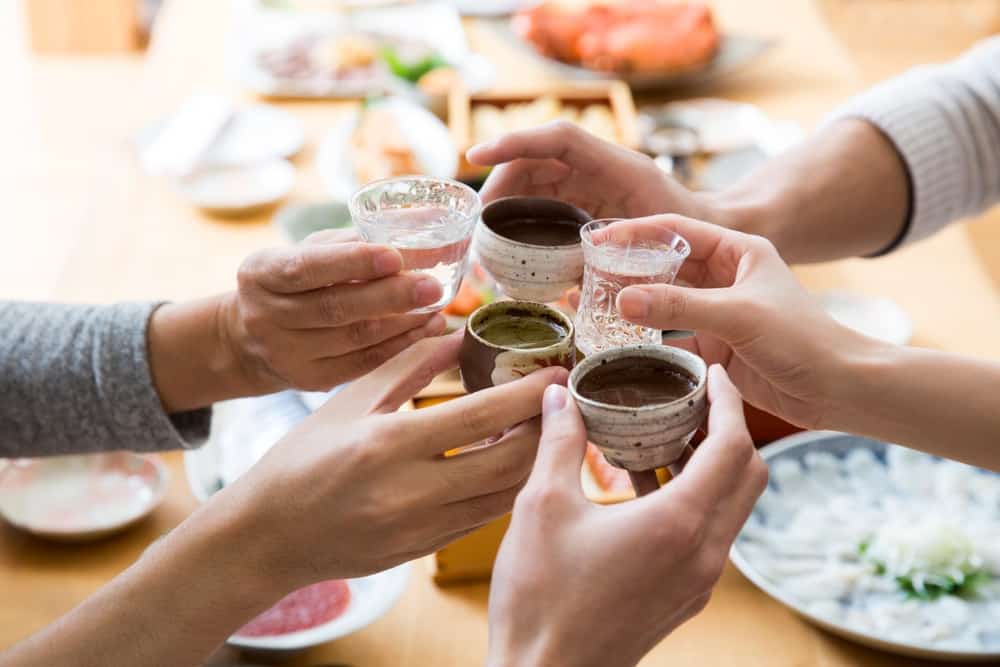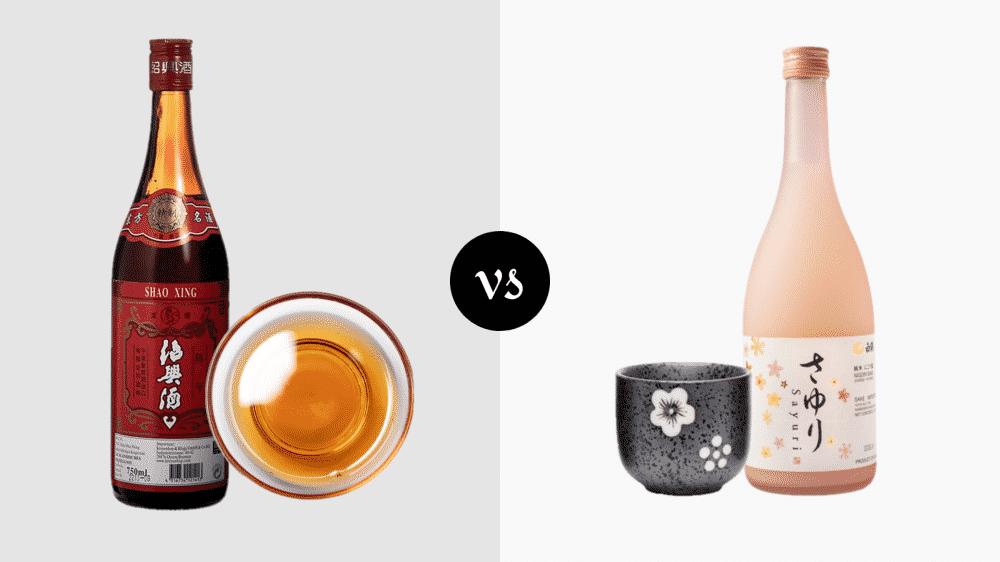
Ranging from beef stews to bakes and mussels to beef bourguignon, multiple recipes call for wine. Wine adds a distinct flavor and texture to various recipes.
There are many different wines used for this purpose, but Shaoxing wine and sake are two of the most widely used Asian favorites. Unfortunately, these two wines are often confused as well.
We’re sharing all the information you need to decide which is better between Shaoxing wine vs. sake for your next meal.
Shaoxing Wine vs. Sake Comparison
| Shaoxing Wine | Sake | |
|---|---|---|
| Definition | Dark Amber Chinese Rice Wine Also Known As YelloW Wine With Sweet & Savory Flavor | Pale Green To Light Yellow Japanese Cooking Wine Made From Polished Fermented Rice With Clean Fresh Flavor & Subdued Sweetness |
| Origin | Shaoxing City, Zhejiang Province, China - Over 2000 Years Ago | 300BC-250AD, Japan |
| Varieties | Huadiao Wine, Standard Shaoxing Cooking Wine | Regular Sake - Futsū-shu | Special Designation Sake - Tokutei Meishō-shu |
| Flavor | Full Rich Astringent Flavor Similar To Dry Sherry With Sharp Sweetness And Lingering Saltiness | Dry Sweet Neutral Spirit Inclusive Of Fruit, Floral & Herbaceous Notes With Varying Astringency, Dryness & Sweetness |
| Ingredients | Water, Fermented Glutinous Rice, Wheat-Based Yeast | Rice, Kōji Rice Mold, Yeast, Distilled Alcohol, Water |
| Alcohol Concentration | 15%-25% | 15%-20% |
| Cuisine | Chinese, Taiwanese, South East Asian | Japanese Cuisine - Nimono & Yakimono Recipes |
| Best Uses | Drink Before Meal In Place Of Rice, Meat Marinades, Dumpling Filling, Potsticker Filling, Deglazing Wok, Stir Fries, Braised Meat, All Types Of Seafood, Removing Fishy Odor From Seafood | Marinade For Meat & Fish, Removes Fishy Smell, Flavor Enhance For Soups, Stews & Stocks, Consumed As Beverage Either Chilled Or Warmed |
Shaoxing Wine vs. Sake
Each is sweet and packed with culinary uses, but Shaoxing wine and Sake are two very different ingredients. Here’s a comprehensive comparison of two of the most popular cooking wines around, especially in Asian cuisine.
Shaoxing Wine
It’s the flavor behind chow mein and the number one reason that Chinese fish dishes taste so different from the rest. Shaoxing wine is a must-have for anyone cooking Chinese food but is equally as versatile in other places in the kitchen.
Here’s a breakdown of everyone’s favorite dark rice wine.
What Is Shaoxing Wine?
Shaoxing wine is a dark amber-colored rice wine created for cooking that’s at times spelled Shao-Hsing. This popular variety, also known as yellow wine, is loved for its sweet flavor and excellent versatility.
It’s a must-have ingredient for authentic flavor in Chinese cuisine that’s widely used in Chinese restaurants for soup broths, stir-fries, wontons, and marinades. It wouldn’t be wrong to say that Shaoxing wine is a part of nearly every Chinese recipe out there.
Origin
Shaoxing wine was first produced in Shaoxing, a large city in the Zhejiang Province of China famous for making excellent rice wine. It is believed to originate over 2000 years ago, although the exact date of origin is unknown.
Varieties
There are many different varieties of Shaoxing wine in China, but all are quite similar in taste. The two primary varieties found in the USA are Shaoxing huadiao wine and standard Shaoxing cooking wine.
Haudiao is the aged variety that adds approximately ten percent extra rice during fermentation, whereas standard Shaoxing follows the traditional quantities and method.
Flavor
Unlike other light flavored clear rice cooking wines, dark-colored Shaoxing has a fuller, richer flavor. The same flavor notes are there, but they’re far more pronounced in Shaoxing wine.
Expect the taste of alcohol to come through boldly while the sharp sweetness is offset by saltiness, ideal for cooking. While far sharper and tart-like in its sweetness, Shaoxing wine tastes similar to dry sherry.
Ingredients
Shaoxing wine contains water, rice, and wheat. The average breakdown of most ingredients falls at approximately 55% water, 40.3% fermented glutinous rice, and wheat-based yeast at 5.6%. Unfortunately, the wheat content makes it not gluten-free.
Although not as common, Shaoxing can be made from sorghum or millet instead of rice.
Alcohol Concentration
This versatile Chinese wine only has 15% to 20% alcohol content. At times, the alcohol concentration can reach as high as 25% although lower strength Shaoxing is far more common.
Cuisine
As mentioned, Shaoxing wine is a foundational ingredient in Chinese cuisine. It also features throughout Taiwan and the rest of SouthEast Asia. Every Chinese restaurant across the world uses Shaoxing as a core ingredient in Chinese food.
Bests Uses
Traditionally, Shaoxing wine is drunk as is before a Chinese meal. It is consumed in place of rice and drunk out of rice bowls. However, it is far more common to find Shaoxing as a base flavor in marinades for meats, dumpling fillings, and potstickers.
It’s also ideal for deglazing your wok and adding immense flavor to whatever you may be cooking, from sauces to stir-fries and braised meat and seafood. It’s particularly good at getting rid of the offputting fishy odor of certain seafood, particularly if it’s frozen.
Traditional Chinese cuisine relies on Shaoxing wine for Hong Shao meals which are basically red dishes such as Hong Shao Yu, which is red braised Chinese fish, and Hong Shao Rou, which is red Shanghai-style braised pork belly.
You’ll also find Shaoxing as the main ingredient in “Drunken Chicken” and other recipes that use the same form of brining.
Sake
Traditionally sipped from porcelain cups when consumed in its homeland Japan, Sake is a world-famous drink with countless cooking applications. Let’s take a closer look at this savory, umami, fresh spirit alcohol and how you can best put it to use.
What Is Sake?
Sake is a Japanese alcoholic beverage and cooking wine ranging from pale green to light yellow that’s made from polished fermented rice. Most treasure sake for its clean, subdued sweetness that complements savory flavors well.
All types of Sake are brewed from a rice variety called sakamai, which has larger grains unsuitable for eating but perfect for polishing and fermenting into alcohol.
Origin
While the exact date of origin is unknown, Sake was first produced during the 3rd century BCE, just after Japan began the wet cultivation of rice. The first reference to commercial manufacturing is found during the 8th century.
It is believed that Sake was invented during the Yayoi period, which falls between 300 BC and 250 AD. It was during this period that rice cultivation spread from China to Japan.
Varieties
There are multiple variants of Sake out there, but there are two primary categories – ordinary Sake known as Futsū-shu and special designation sake termed Tokutei meishō-shu.
Ordinary Sake is the Japanese equivalent of table wine, whereas special designation sake and its eight varieties reflect high-quality wine with varying degrees of rice polishing.
Flavor
Sake has varying flavors based on the gravity of the Sake and the alcohol content. Three specific markers on each sake bottle give an indication of what it will taste like. Nihonshu-do ranges between -3, indicating the sweetest wine, and +10, indicating the dryest.
One must consider the Nihonshu-do and the San-do rating to determine how rich the Sake is and the ratio of dry to sweet. San-do shows how much acid is present in the Sake, which neutralizes sweet tastes and extends them towards dryness.
Aminosan-do indicates the degree of umami flavor, showing how savory the Sake is. The base taste of Sake is neutral alcohol but keep in mind that Sake often includes other flavors like fruit, flowers, and various herbs and spices.
Ingredients
The two basic classifications of Sake, namely Futsū-shu and Tokutei meishō-shu, are both made from rice, Kōji rice mold, yeast, distilled alcohol, and water. Sake brewing uses polished rice, which is brown rice that has had its surface polished away to a particular degree.
Polishing can be seen as scraping the surface down. The fat and protein present in the outer layers of rice may be rich in nutrients, but they also have a strong flavor that needs to be polished away in order to release the desirable flavors and aroma present in sake.
Alcohol Concentration
Sake has 15% to 20% alcohol content. Generally, sake wines are aged for years, and every variant will have different alcohol content.
Cuisine
You’ll find Sake used throughout Japanese cuisine. In Japan, it is a staple in nimono, which are simmered dishes, and yakimono, which are grilled dishes.
Bests Uses
When used for cooking, Sake is an excellent aid in marinating meat and fish. Cooks find it invaluable for removing the intensely fishy smell of fish. It’s also a fantastic flavor enhancer for soups, stews, and stocks. Adding Sake to your food fuses a naturally sweet, almost tart flavor with light umami undertones.
Higher quality sake is served chilled when served for drinking, whereas cheaper varieties are warmed up as warming sake brings out its full flavor. Cheaper Sake has a rough taste that becomes fruitier and sweet once warmed. Serve it chilled at around 40°F or heat to above 150°F to promote a more complex depth of flavor.
What Is The Difference Between Shaoxing Wine vs. Sake?
The main difference between Shaoxing wine and Sake is that Shaoxing is a Chinese cooking wine with a sweet yet savory, slightly salty flavor profile, whereas Sake is a Japanese wine made for drinking that’s extremely useful in cooking thanks to its light, sweet, neutral taste.
Shaoxing Wine vs. Sake, Conclusion
Most US foodies won’t find themselves drinking Shaoxing because of its saltiness, whereas the satisfaction that good sake gives as a beverage is undeniable.
Both are outstanding cooking wines, but you won’t be using Sake in Chinese food and vice versa for Shaoxing in Japanese cuisine.
There’s no clear winner between Shaoxing vs. Sake – both are must-have ingredients for anyone who wants to cook up food with authentic local restaurant-quality flavor.

